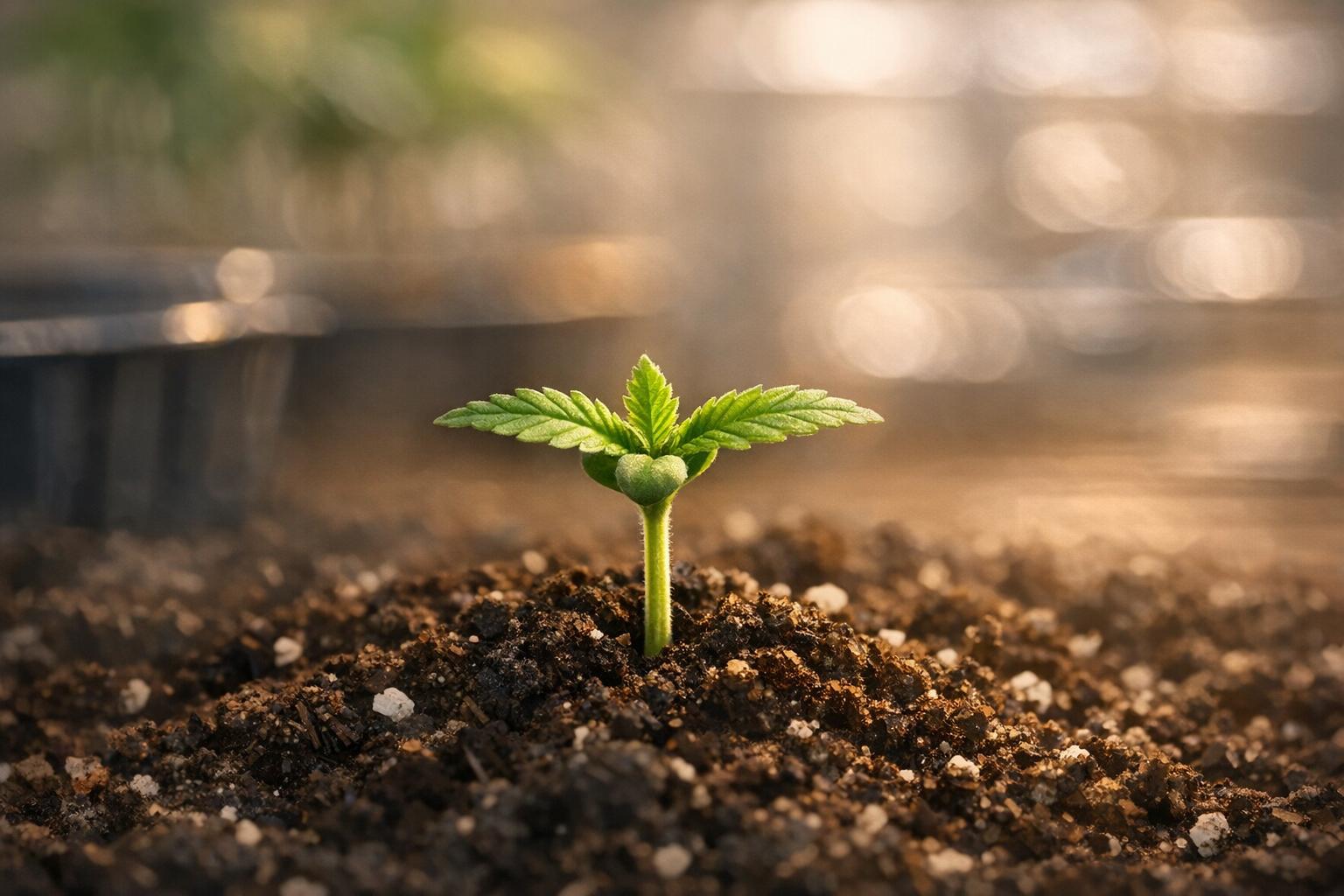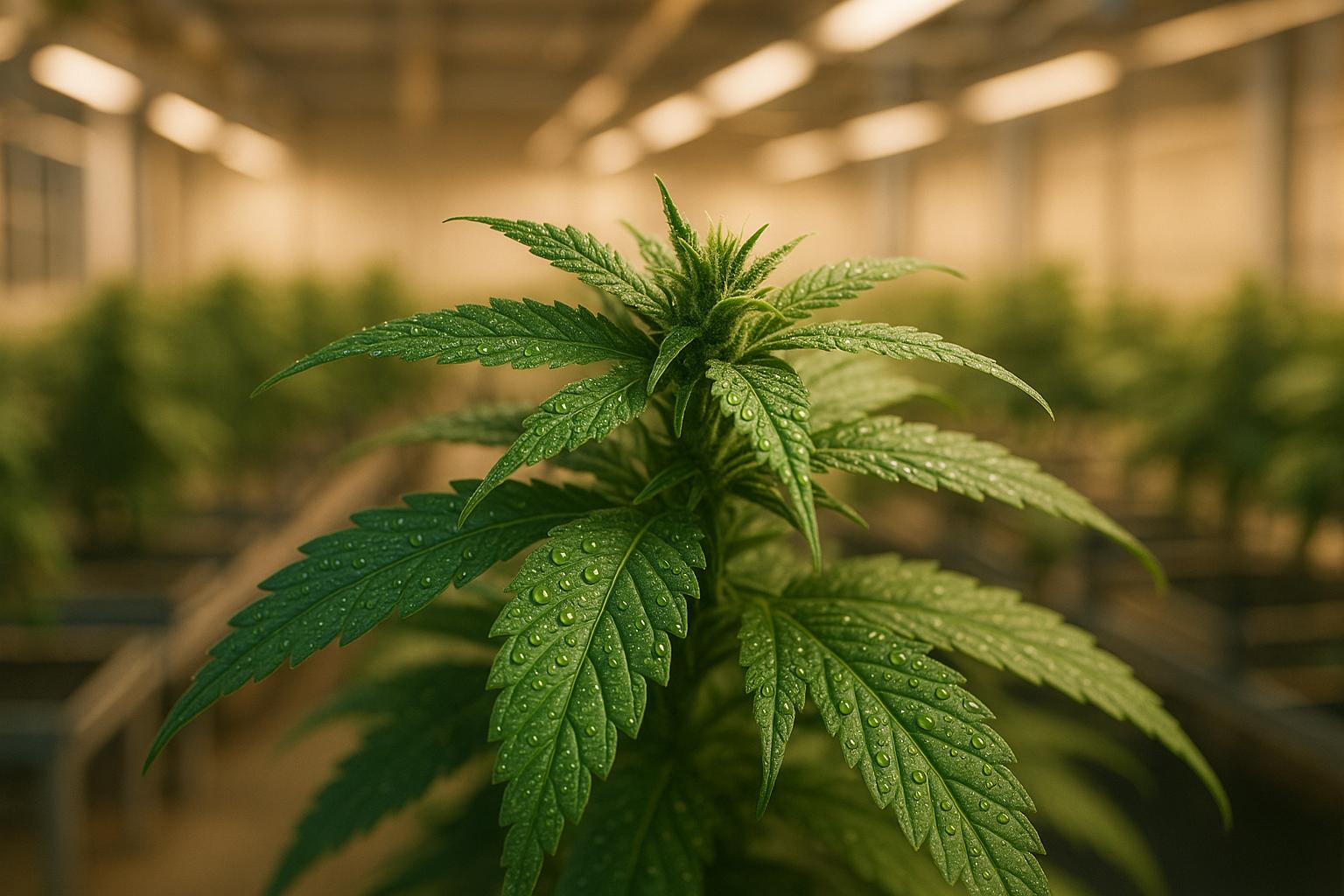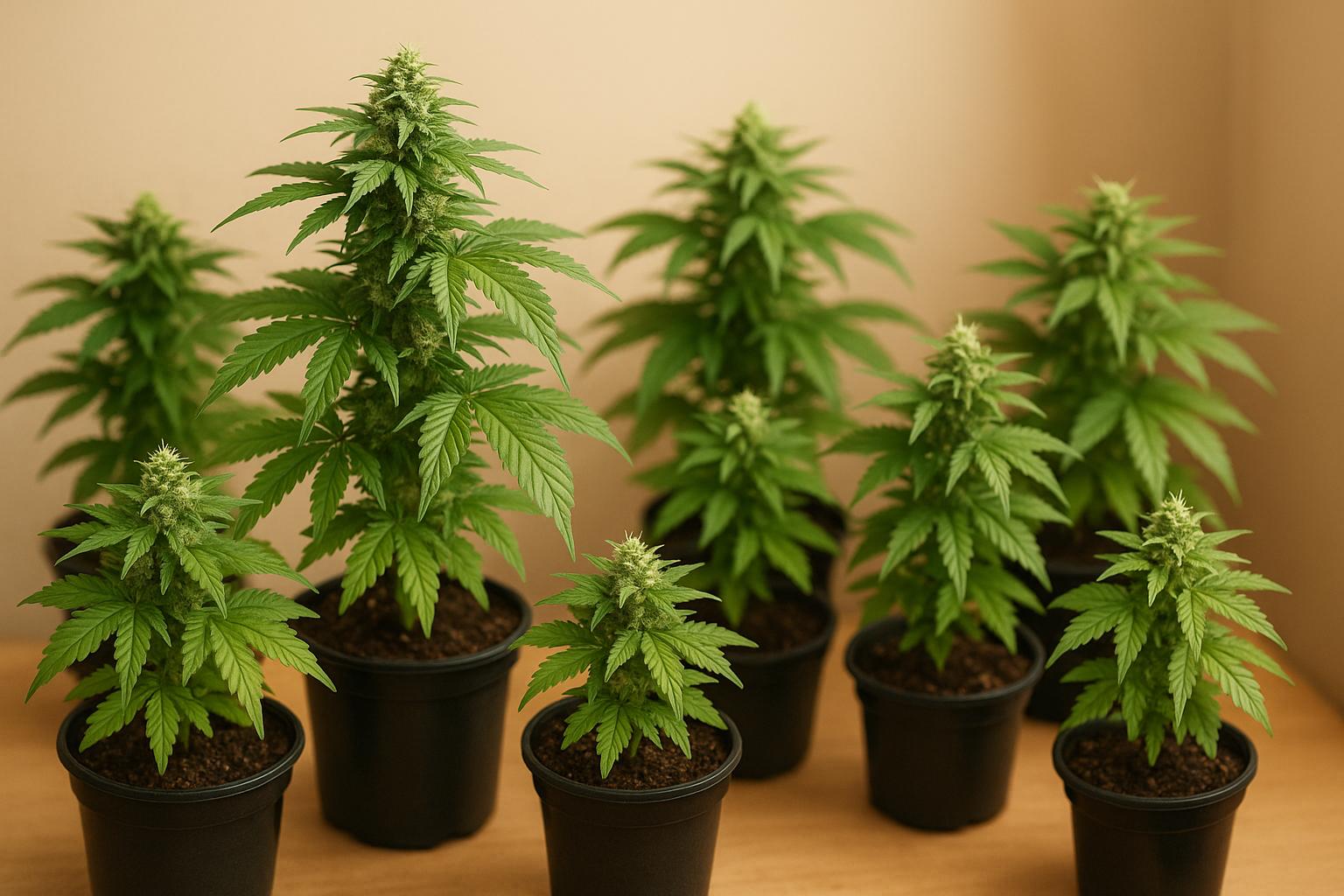Pheno-hunting is the process of identifying standout cannabis plants with desirable traits, such as potency, flavor, yield, or pest resistance. By growing multiple plants from the same strain, growers can evaluate variations in how genetics (genotype) interact with growing conditions to express different traits (phenotype). Here's a quick overview of key methods:
- Observation and Record Keeping: Track plant growth, flowering, and environmental factors using consistent logs and photos.
- Trait Measurement: Analyze cannabinoid levels, terpene profiles, yield, and structural traits like height and branching.
- Digital Tools: Use apps, sensors, and software for data tracking, visualization, and genetic lineage tracing.
- Genetic Testing: Employ DNA markers to identify traits early, and preserve elite plants through tissue culture.
For small-scale growers, focus on 10–20 plants per strain, use affordable tools for monitoring, and prioritize high-quality seeds from reputable sources. Combining data-driven methods with hands-on experience ensures better results. Visit platforms like Cannabis Seeds Directory for reliable seed options and resources.
Data-Based Methods for Pheno-Hunting
Systematic Observation and Record Keeping
Keeping thorough, consistent records is the backbone of effective pheno-hunting. From germination to harvest, documenting key data points ensures you capture the full picture of a plant's development. Start by tracking germination rates, seedling vigor, vegetative growth patterns, flowering onset, and final yields. By using standardized measurement methods across all plants, you can make meaningful comparisons between them.
Set up weekly observation schedules, but be prepared to increase the frequency during flowering. This stage often requires closer monitoring to capture details like trichome development, pistil changes, and aromatic profiles. Don’t overlook the environmental factors - log temperature shifts, humidity levels, nutrient regimens, and lighting conditions. Adding photographic evidence under consistent settings creates a visual timeline that complements written notes, helping you spot subtle differences that might otherwise go unnoticed. These detailed records form the foundation for accurate trait evaluation.
Measuring Plant Traits
Once you’ve gathered systematic records, use them to measure traits with precision. This step transforms observations into actionable data, guiding your selection process. Focus on traits that impact cultivation success and product quality. For instance, cannabinoid analysis is a trusted method for evaluating potency. Use portable testers or lab analyses to measure levels of THC, CBD, and other cannabinoids like CBG, CBN, and CBC.
Terpene profiling is becoming increasingly important as consumer preferences shift. Using gas chromatography, you can identify specific terpene concentrations, which provide clues about whether a plant delivers relaxing or energizing effects. Yield measurements are equally essential. Assess the ratio of usable flower to total plant material, analyze stem thickness, and evaluate branch density to understand a plant's production efficiency. Structural traits like height and internodal spacing also reveal which plants are likely to produce a denser, more manageable canopy.
To evaluate resistance traits, introduce controlled environmental stresses. For example, minor temperature changes or brief nutrient deficiencies can help identify plants that thrive even under less-than-ideal conditions.
Digital Tools for Plant Tracking
Digital tools make it easier to organize your data and uncover patterns you might otherwise miss. For smaller-scale operations, customizable spreadsheet templates work well for recording details like leaf texture, stem color, or specific aromatic compounds. On the other hand, advanced cultivation software offers features like automated data visualization, statistical analysis, and predictive modeling, which can refine your selection criteria over time.
Mobile apps designed for plant tracking simplify real-time data entry during garden walks, reducing the risk of missed observations. Many apps also integrate photographic documentation, automatically timestamping images to create a combined visual and numerical record. For larger operations, QR codes provide a quick and accurate way to track multiple plants.
Digital tools also allow you to trace genetic lineages across generations, helping you identify parent plants that consistently produce superior offspring. Beyond individual efforts, these tools enable collaborative pheno-hunting by allowing growers to share and compare data on the same genetic lines. This collective approach can accelerate the discovery of standout phenotypes.
Phenohunting and Breeding Stable Cannabis Seeds with Nathaniel Pennington
Genetic Testing Methods in Pheno-Hunting
Genetic testing takes pheno-hunting to the next level by refining candidate selection early in the process, building on data from trait measurements.
DNA Marker Selection
DNA markers are powerful tools for identifying desirable traits in seedlings long before they mature. These markers allow growers to screen for attributes like high cannabinoid levels, disease resistance, or specific terpene profiles without waiting for the plants to flower.
One commonly used tool is single nucleotide polymorphisms (SNPs), which can highlight traits such as cannabinoid ratios, flowering time, and overall plant structure. By analyzing leaf tissue, growers can quickly narrow down candidates, saving time and resources.
This method is especially helpful when searching for rare traits. For instance, when targeting plants with naturally high levels of CBG, DNA markers can pinpoint promising seedlings shortly after germination. This eliminates the need to rely solely on chemical analyses later in the growth cycle, making the entire process more efficient.
To further support pheno-hunting, tissue culture techniques ensure that elite genotypes are preserved for future use.
Tissue Culture and Clone Production
Tissue culture is an advanced method for preserving elite phenotypes. It involves growing plant cells in a sterile, nutrient-rich environment, which helps prevent contamination and genetic drift.
One specific technique, meristem culture, isolates the tips of plants to produce virus-free, genetically stable mother plants. By using specialized hormone media, this method encourages rapid cell division and rooting.
The sterile lab environment used in tissue culture significantly reduces the risk of pathogens and fungal infections. As a result, plants produced through this method often show better vigor, faster rooting, and stronger immunity compared to clones propagated through traditional methods.
For cannabis growers, commercial tissue culture services are available to maintain genetic libraries under controlled conditions. This ensures that specific phenotypes can be stored long-term and retrieved for future breeding projects.
Lab Testing vs. Field Selection
Both laboratory-based genetic testing and traditional field selection offer unique benefits, and combining them can improve pheno-hunting outcomes.
Lab tests, such as HPLC and GC-MS, provide precise cannabinoid and terpene profiles, making it easier to identify traits early in the process. On the other hand, field selection is essential for evaluating traits like plant structure, adaptability, and pest resistance in real-world conditions. These insights are crucial for understanding how genetics interact with environmental factors, especially under stress.
sbb-itb-1add288
Step-by-Step Pheno-Hunting Process
To kick off your pheno-hunting journey, start by sourcing top-notch seeds. A great resource for this is the Cannabis Seeds Directory, which connects you to trusted seed banks like Alpine Seed Group, Atlas Seeds, Authentic Genetics, and Grounded Genetics. This step sets the stage for a methodical and science-based approach to pheno-hunting. Once you’ve secured your seeds, the next focus is on seed selection and early germination - critical steps to building a strong foundation for your project.
Seed Selection and Germination
Choosing high-quality seeds is widely regarded as the cornerstone of any successful cannabis pheno-hunting endeavor. This ensures you’re starting with the best possible genetics, giving you a solid advantage as you move forward.
Resources for Home and Craft Growers
Home and craft growers can achieve results similar to professional pheno-hunting by using smart, cost-effective strategies tailored to smaller budgets and spaces.
Pheno-Hunting for Small-Scale Growers
Even with limited resources, small-scale growers can adopt scientific methods to achieve precise results. The trick lies in modifying laboratory techniques to suit a home-growing setup while still collecting reliable data.
Start by keeping your focus manageable - limit each strain to 10–20 plants. This allows you to closely monitor their development without overextending your space or budget. Take daily photos with consistent lighting and angles to document visual changes over time.
To track environmental conditions, use affordable digital sensors that connect to smartphone apps. These tools provide accurate readings of temperature and humidity, offering data similar to what you'd find in advanced labs.
For cannabinoid profiling, craft growers can either collaborate with local labs or invest in portable testing devices. Testing at key growth stages helps identify valuable phenotypes, guiding your selection process.
Maximize your growing area by using vertical setups or modular systems. These configurations let you isolate plants for detailed observation while making the most of your space. By applying these straightforward techniques, small-scale growers can align their practices with professional standards, paving the way for better results.
Finding Quality Seed Sources
The foundation of any successful pheno-hunting project is high-quality, genetically diverse seeds. Poor genetics can derail even the most meticulous process, so careful seed selection is essential.
Cannabis Seeds Directory is a trusted platform that connects growers with reputable breeders offering seeds with documented genetic histories. These records are crucial for planning your pheno-hunting project, as they provide insights into lineage and breeding practices.
When choosing seeds, look for breeders who offer detailed genetic information and maintain consistent records of their mother plants. Whether you're seeking F1 hybrids for greater phenotypic variety or stabilized lines for uniformity, the right seed source can make all the difference.
For broader genetic diversity, consider ordering seeds from multiple breeders working with the same strain. This approach allows you to compare how different breeding programs express genetic traits, helping you find phenotypes that best match your growing conditions and goals. Beyond just sourcing seeds, having access to expert advice and community support can significantly enhance your project.
Learning Resources and Support
To refine your pheno-hunting skills, combine scientific methods with strong educational support. Cannabis Seeds Directory doesn't just provide seeds; it also offers a wealth of resources for growers at all experience levels.
Many breeders on the platform include growing guides and phenotype descriptions with their collections. These materials serve as helpful references for your observations. Additionally, the platform's customer support team can assist with troubleshooting and interpreting phenotypic variations, offering guidance that blends both scientific and practical insights.
Global shipping options ensure access to diverse genetics, no matter where you're located. Plus, the platform emphasizes genetic preservation, so you can trust the authenticity of the seeds you purchase. Many breeders also host online forums and communities where growers share tips and experiences, creating a space for learning and collaboration.
To further streamline your process, you can access tools like documentation templates and tracking sheets. These resources help you maintain consistent data collection practices, ensuring that your pheno-hunting efforts are both organized and effective.
Key Points on Scientific Pheno-Hunting
Summary of Scientific Methods
Scientific pheno-hunting relies on a mix of observation, data collection, and genetic analysis to identify standout cannabis phenotypes. By combining measurable plant traits with genetic insights, growers can make precise, informed decisions.
Standardized methods play a big role in evaluating plant traits. Tools like digital sensors and apps help track environmental factors such as temperature and humidity, which influence phenotypic expression.
Genetic testing adds another layer of precision. Techniques like DNA marker selection can reveal desirable traits early in the plant's life cycle, while tissue culture methods allow for the exact replication of chosen phenotypes. Laboratory cannabinoid profiling provides a chemical breakdown of the plant, offering objective data to complement field observations.
The process itself is highly structured. It begins with choosing seeds carefully, followed by controlled germination and clone production during the vegetative stage. Final decisions are made by combining flowering performance data with chemical analysis, ensuring the selected plants meet cultivation and product quality goals.
Thorough documentation is essential every step of the way. Using standardized templates, daily photos, and regular logs creates a reliable dataset, enabling growers to make smarter choices.
Together, these methods lay the groundwork for effective growing strategies.
Final Advice for Growers
To succeed in pheno-hunting, it’s important to balance your aspirations with the resources you have. Starting with 10 to 20 plants per strain is a practical way to keep observations detailed without becoming overwhelmed by data collection.
Investing in high-quality genetics is a must. Poor genetics can undermine even the most careful methods. Look for seeds with documented lineages and breeding histories to better understand phenotypic variations and predict outcomes.
Tailoring professional methods to your specific setup is another key to success. Home and craft growers can adapt scientific techniques to smaller spaces and budgets. Portable testing tools and smartphone sensors now make advanced monitoring more accessible, while connecting with the grower community and continuing to learn will refine your skills over time.
For those looking to achieve outstanding results, combining scientific precision with hands-on experience is the most reliable path to discovering top-tier cannabis phenotypes. To get started on the right foot, check out Cannabis Seeds Directory (https://cannabis-seeds.org) for trustworthy sources of premium cannabis seeds.
FAQs
What are some budget-friendly ways for small-scale cannabis growers to use scientific methods for pheno-hunting?
Small-scale growers can embrace scientific pheno-hunting techniques without draining their wallets by sticking to practical, affordable methods. One effective strategy is to start with a small batch of seeds and grow them in budget-friendly containers, like 2.5-gallon (10-liter) self-watering pots. Another savvy move is cloning each plant. This lets you evaluate traits under different growing conditions while keeping expenses in check.
Opting for outdoor or greenhouse setups can also help cut costs. By harnessing natural sunlight and environmental factors, growers can avoid the need for expensive equipment. To make the process even more effective, keeping detailed records of plant growth, traits, and yields is crucial. These straightforward, data-focused steps allow small-scale growers to pinpoint standout phenotypes and achieve impressive results - all without overspending.
What are the benefits of using DNA markers in pheno-hunting, and how do they make the selection process more efficient?
Using DNA markers for pheno-hunting offers cannabis breeders a range of advantages. These markers make it possible to pinpoint genetic traits with precision, moving beyond just physical observations that can be skewed by environmental conditions. This approach speeds up the selection process while making it more reliable.
Another benefit is the ability to target specific genetic variations, which simplifies the creation of new strains with desirable features. When paired with advanced tools like genomic selection, DNA markers take breeding to the next level by predicting a plant's genetic potential. This not only saves time but also cuts down on resource use. By integrating these data-driven techniques, breeders can produce more consistent outcomes and elevate the quality of cannabis strains.
How do digital tools and apps help with tracking and analyzing cannabis traits during pheno-hunting?
Digital tools and apps have become game-changers for pheno-hunting, simplifying the process of tracking, documenting, and analyzing cannabis plant traits with a high level of precision. With these tools, growers can log detailed, real-time observations of phenotypic traits like growth patterns, aroma, color, and potency.
By leveraging a data-driven approach, growers can efficiently compare and analyze plant characteristics, pinpoint desirable traits, and make well-informed breeding choices. These technologies not only streamline the process but also improve accuracy, allowing both craft and home growers to achieve better results while selecting top-tier genetics for future cultivation efforts.



